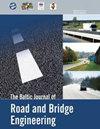The Use of Bloss Curve in The Exit Lanes of Road Intersections
IF 1.1
4区 工程技术
Q4 ENGINEERING, CIVIL
引用次数: 1
Abstract
The paper proposes the use of the Bloss curve (also known as biparametric or bi-hyperclothoid) as a braking curve in the exit lanes of road intersections. The main international standards continue using the clohoid as the principal transitional geometric element, even though the limits of its use in driving regimes with non-uniform speeds are known. The proposal to use the Bloss curve is aimed at overcoming these limitations and opening a debate on the possible need to codify, even in the international standards, the use of more suitable alternative braking curves. In this context, a kinematic study was conducted by comparing the main parameters of the motion (lateral jerk, lateral acceleration, steering speed) between the Bloss curve and more traditional curves, such as clothoid and Generalized Cornu Spirals (GCS). Nine case studies were conducted, each case was characterized considering the type of transition curve used (clothoid, GCS and Bloss curve) and radius R of the exit curve (R = 60 m, 80 m, 100 m). The numerical values assumed by the kinematic variables along the transition curves were “locally” calculated, i.e. “pointby- point”, to take into account the non-uniform motion regime. The results obtained, limited to the cases studied, show that the Bloss curve better meets the kinematic conditions of the vehicle motion in non-uniform driving regimes. Therefore, the Bloss curve can be considered as a braking curve in the design of road intersections and be a candidate for further investigation to assess any additional benefits in terms of comfort, driving safety and visual perception of the geometric element.损失曲线在交叉口出口车道中的应用
本文提出了在道路交叉口出口车道使用blloss曲线(也称为双参数曲线或双超线曲线)作为制动曲线。主要的国际标准继续使用clocloid作为主要的过渡几何元素,尽管它在非均匀速度的驾驶制度中使用的限制是已知的。使用布洛斯曲线的建议旨在克服这些限制,并就可能需要编纂,甚至在国际标准中,使用更合适的替代制动曲线展开辩论。在此背景下,通过比较blloss曲线和更传统的曲线(如clodroid和Generalized Cornu Spirals, GCS)之间的运动主要参数(侧向加速度、侧向加速度、转向速度),进行了运动学研究。对9个案例进行了研究,每个案例都考虑了所使用的过渡曲线类型(clothoid, GCS和Bloss曲线)和出口曲线的半径R (R = 60 m, 80 m, 100 m)。考虑到非均匀运动状态,运动学变量沿过渡曲线的数值是“局部”计算的,即“逐点”计算。研究结果表明,在非均匀工况下,blloss曲线较好地满足了车辆运动的运动学条件。因此,可以将loss曲线视为道路交叉口设计中的制动曲线,并作为进一步研究的候选曲线,以评估几何元素在舒适性,驾驶安全性和视觉感知方面的任何额外好处。
本文章由计算机程序翻译,如有差异,请以英文原文为准。
求助全文
约1分钟内获得全文
求助全文
来源期刊
CiteScore
2.10
自引率
9.10%
发文量
25
审稿时长
>12 weeks
期刊介绍:
THE JOURNAL IS DESIGNED FOR PUBLISHING PAPERS CONCERNING THE FOLLOWING AREAS OF RESEARCH:
road and bridge research and design,
road construction materials and technologies,
bridge construction materials and technologies,
road and bridge repair,
road and bridge maintenance,
traffic safety,
road and bridge information technologies,
environmental issues,
road climatology,
low-volume roads,
normative documentation,
quality management and assurance,
road infrastructure and its assessment,
asset management,
road and bridge construction financing,
specialist pre-service and in-service training;

 求助内容:
求助内容: 应助结果提醒方式:
应助结果提醒方式:


